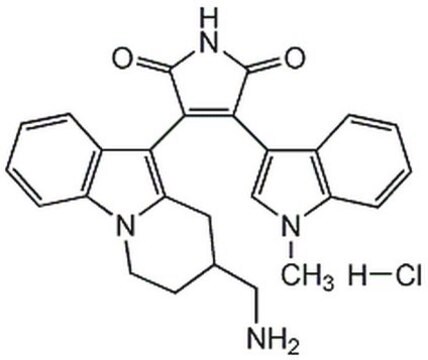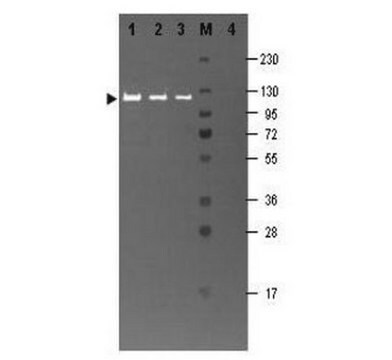G7420
Galectin-1 human
recombinant, expressed in E. coli, ≥95% (SDS-PAGE), lyophilized powder
Se connecterpour consulter vos tarifs contractuels et ceux de votre entreprise/organisme
About This Item
Produits recommandés
Source biologique
human
Niveau de qualité
Produit recombinant
expressed in E. coli
Pureté
≥95% (SDS-PAGE)
Forme
lyophilized powder
Numéro d'accès UniProt
Application(s)
cell analysis
Température de stockage
−20°C
Informations sur le gène
human ... LGALS1(3956)
Description générale
Galectin-1 is a member of the family of animal lectins, which selectively binds β-galactoside residues.
Application
A common function of galectins is to cross-link structures containing N-acetyl-lactosamine located at the cell surface and within the extracellular matrix. They also possess hemagglutination activity, which is attributable to their bivalent carbohydrate binding properties. They have variable affinity for more complex oligosaccharides. Other activities of galectin-1 include cell differentiation and inhibition of CD45 protein phosphatase activity.
Actions biochimiques/physiologiques
Galectin-1 has been implicated in metastasis and aggregation of cancer cells based on its association with the glycoprotein 90K. Galectin-1 may play a significant role in cancer through apoptosis, cell adhesion, migration, cell cycle regulation and tumor evasion of immune responses.
Galectin-1 has been implicated in metastasis and aggregation of cancer cells based on its association with the glycoprotein 90K. Galectin-1 may play a significant role in cancer through apoptosis, cell adhesion and migration, regulation of the cell cycle and tumor evasion of immune responses.
Forme physique
Lyophilized from a 5 mg/mL solution in phosphate buffered saline containing 8 mM DTT and 150 mM lactose.
Produit(s) apparenté(s)
Code de la classe de stockage
13 - Non Combustible Solids
Classe de danger pour l'eau (WGK)
WGK 2
Point d'éclair (°F)
Not applicable
Point d'éclair (°C)
Not applicable
Certificats d'analyse (COA)
Recherchez un Certificats d'analyse (COA) en saisissant le numéro de lot du produit. Les numéros de lot figurent sur l'étiquette du produit après les mots "Lot" ou "Batch".
Déjà en possession de ce produit ?
Retrouvez la documentation relative aux produits que vous avez récemment achetés dans la Bibliothèque de documents.
F Archambeaud-Mouveroux et al.
Gastroenterologie clinique et biologique, 11(1), 93-95 (1987-01-01)
A case of secondary syphilitic hepatitis is reported. A 49-year old woman was admitted for weight-loss, fever, hepatomegaly and splenomegaly. Diagnosis of syphilitic hepatitis was based on cholestasis associated with positive serologic tests for syphilis without other immunological disturbances. Biopsy
Antonino Grassadonia et al.
Glycoconjugate journal, 19(7-9), 551-556 (2004-02-06)
Galectins and their ligands have been implicated in cell transformation and cancer metastasis, and found to have prognostic value. Mac-2 BP, also known as 90K, is a highly glycosylated, secreted protein extensively studied in human cancer, which binds galectin-1, galectin-3
Zanka Bojić-Trbojević et al.
Histochemistry and cell biology, 142(5), 541-553 (2014-05-24)
Mucins are multifunctional highly glycosylated proteins expressed by the female reproductive tract. Differential expression of MUC1 and MUC15 has been shown in trophoblast. This study was undertaken to establish the distribution of mucin(s) in cytotrophoblast cell cultures using anti-bovine submaxillary
V D Yakushina et al.
Molecular and cellular biochemistry, 398(1-2), 245-249 (2014-10-09)
CD4(+) T cells orchestrate the immune response by differentiating into T helper (Th) or regulatory (Treg) cell subsets that secrete distinct sets of cytokines. They also play a critical role in the pathogenesis of autoimmunity, asthma, allergy and, likely, cancer.
Sandra Thiemann et al.
The Journal of biological chemistry, 290(37), 22662-22677 (2015-07-29)
During inflammation, dendritic cells emigrate from inflamed tissue across the lymphatic endothelium into the lymphatic vasculature and travel to regional lymph nodes to initiate immune responses. However, the processes that regulate dendritic cell tissue egress and migration across the lymphatic
Notre équipe de scientifiques dispose d'une expérience dans tous les secteurs de la recherche, notamment en sciences de la vie, science des matériaux, synthèse chimique, chromatographie, analyse et dans de nombreux autres domaines..
Contacter notre Service technique







